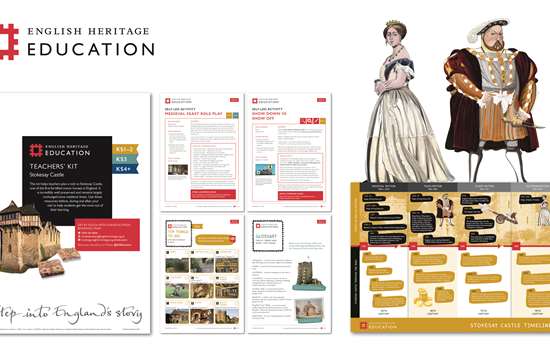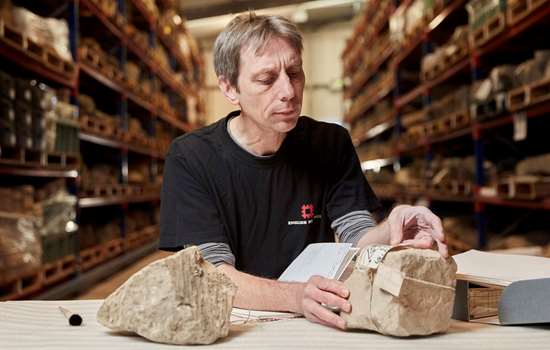Hints and Tips
- Remember the ‘big three’– the three main contenders for Edward the Confessor's throne in 1066 were: Harold Godwinson, Earl of Wessex, Harald Hardrada from Norway, and William, Duke of Normandy.
- The Norman Conquest is often described as ‘significant’ or ‘transformational’ – Using this as the basis of an overarching enquiry question can be useful for structuring students’ learning and getting them to consider change and continuity through the time periods.
- Anglo-Saxons and Normans were people too – studying these periods can often feel like memorising a list of battles and weapons. Look for opportunities to bring in aspects of social history and role play to maintain interest and balance.
Suggested Activities
-

1066 Battle of Hastings Role Play (KS3) - Battle Abbey Teachers' Kit
Place yourself at the heart of the Battle of Hastings with this immersive role play activity.
-

1066 Design Your Own Norman Castle (KS3-KS4+) - Pevensey Castle Teachers' Kit
Establish your power and authority in Norman England by designing your own Norman castle.
-

1066 Plan Your Campaign (KS2-KS3) - Pevensey Castle Teachers' Kit
How would you have planned William of Normandy’s campaign in 1066? Plot your invasion of England with this activity.
-

1066 Draw your Own Reconstruction (KS3-KS4+) - Pevensey Castle Teachers' Kit
Learn from a reconstruction artist to create your own Norman reconstructions.
-

1066 Battle of Hastings Sequencing Activity
Use reconstruction drawings of key moments from the Battle of Hastings to check your understanding of how the battle unfolded.
-

What could Harold have done differently?
Could Harold Godwinson have done anything differently leading up to and during the Battle of Hastings in 1066? Use this activity to draw your own conclusions.
-

1066 Battle of Hastings: William's Fortune Graph
Chart William, Duke of Normandy’s changing fortunes on 14th October 1066 during the Battle of Hastings.
-

Why did William win the Battle of Hastings?
Analyse the reasons for William’s victory at the Battle of Hastings. Identify and organise evidence to make a well-reasoned argument for William’s victory.
History At Home Live! 1066 and the Battle of Hastings
Watch our History At Home Live! with Ben Shires and our expert Roy Porter to deepen your understanding of 1066 and the Battle of Hastings.
Who deserved to be king? How did the events of 1066 play out? Why did William of Normandy emerge victorious? Find out the answers to all these questions and more.
Get to Grips with the Period
Germanic peoples – Angles, Saxons, Jutes and Frisians – came to Britain during the Roman period and afterwards. Anglo-Saxons occupied most of lowland England by the mid-600s and established several independent kingdoms. In the east, the pagan conquerors were converted to Christianity by missionaries from Rome and Ireland. Christian culture blossomed at religious centres like St Augustine's Abbey and Lindisfarne, helping to create the idea of an English nation. In the west, the British population and Christianity had a constant presence throughout the period.
Towards the end of the 8th century, Viking raids became invasions. King Alfred of Wessex fought back and his descendents recovered the Viking-held lands. His grandson, Aethelstan, became the first ruler of a unified England.
In 1066, Edward the Confessor died without an heir and the crown of England was fought over by Harold Godwinson, Harald Hardrada and William of Normandy. William’s victory at the Battle of Hastings began a new era during which castles like Richmond and Pevensey became the instruments and symbols of Norman power.
Read the Story of England here-

Early Medieval: Religion
Christianity in Britain tends to be associated with the arrival of St Augustine in 597, but it had in fact already taken root in Roman Britain.
-

Early Medieval: Power and Politics
This period saw the evolution of a nation of warlords into a country organised into distinct kingdoms.
-

Early Medieval: Architecture
Most early medieval buildings were constructed mainly using wood, but this tradition left its mark on later stone-built churches.
-

Early Medieval: Art
The early medieval period produced many examples of highly distinctive art of world-class significance.
Anglo-Saxons and Normans Glossary
Expert Advice
We asked one of our curators for their thoughts on studying the Anglo-Saxons and Normans:
Read more about Teaching HistoryIt’s immensely rewarding studing the Anglo-Saxon period. This is an age when history emerges from myth, when the kingdom of England was formed and when the foundations of much of our culture were laid.
We can trace so much of modern England to the Anglo-Saxons; from the language we speak to the laws by which we’re governed, from the counties we live in to the customs which characterise our behaviour. Anglo-Saxon society was complex and its culture sophisticated, yet this was also the age of the blood feud, a time when political confrontation often resulted in bloody fighting and one which witnessed brutal wars.
Studying this period means encountering the alien as well as the familiar, and it requires the broadest range of historical enquiry; from the material evidence revealed through archaeology to the documentary evidence of writs and chronicles. Within this vibrant, tumultuous age, we find aspects of ourselves reflected as well as a fascinating culture worthy of study in its own right.
Roy Porter, Senior Properties Curator
Video Resources
Discover more about Anglo-Saxon and Norman England with our variety of videos.
Find out about the history of the Normans and meet an Anglo-Saxon warrior. Investigate who deserved to be king in 1066 and uncover why William of Normandy was victorious at the Battle of Hastings.
-
Meet an Anglo-Saxon Warrior
-
Harold vs. William - Whose Crown?
-
Why William won at the Battle of Hastings
Curators' Collections
Explore objects from our collections at sites like Battle Abbey and Pevensey Castle to learn more about the Norman Conquest, and the changing stories of Norman buildings.
Hear from our experts about how these objects can act as sources, offering us a window on the past, and discover a curator's role in making this happen.
Use objects from our collections at home or in the classroom to inspire cross-curricular learning and further your research.
Read More



